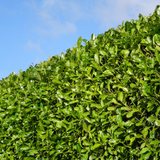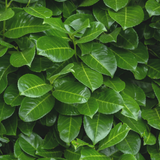150/175cm Root Ball Cherry Laurel
(Prunus Laurocerasus Rotundifolia)
Cherry Laurel is a thick, evergreen hedge with summer flowers and autumn berries- a staple to any garden that promises foliage year-round.
- About̴Ì?Pot Grown Cherry Laurel
- Key Features
- Pruning & Care
Though mainly known for their rich and stunning green foliage, the Cherry Laurel hedging also showcases intricate creamy-white flowers within the spring, which are then followed by red berries to make it look festive in the winter- making it an amazing decorative addition to any size of garden. As the berries are seen as a great welcomed source of food, the Cherry Laurel encourages many birds to your garden, as well as the lovely flowers providing an opportunity to attract bees.
Please note, all parts of the Cherry Laurel (including leaves/berries) are toxic to both humans and animals when consumed.̴Ì?Though the plant does not hold much attraction to pets/children, it is particularly advised to avoid planting near livestock. If you are concerned about your pets and children, it is best to choose Bay Laurel (the only non-toxic Laurel).
Prunus laurocerasus 'Rotundifolia,' is ideal to reduce noise and wind, as well as being perfect to use as a privacy screen. The plant has a seemingly fast growth rate, looking at around 30-60cm per year, and can even be grown to 20/30ft high (though it is easier to maintain at a lower height). That in mind, Laurel hedging does tend to do better as a standalone hedge- but you can plant with other Laurel varieties if you are looking to create a mixed hedge. Although, this plant tends to have a slight spreading habit, which can easily fill any surrounding space of its original planting space (which means there is generally no need to rely on other plants to fill it).
This 150/175cm root ball Cherry Laurel plant can reach up to 5m high when planted in good conditions.
The Cherry Laurel grows well in pretty much every condition, including dry sites or heavily shaded areas (although coastal gardens and alkaline soil is not very suitable), making it the perfect plant for any problem areas within your garden- whether that's parts of the garden with very little sunlight, or just with poor soil. It is also important to consider that it is not recommended to plant the Cherry Laurel next to livestock, as the leaves and berries can both be harmful to animals.
- Growth rate: Average-Fast (40-60cm a year)
- Ideal height: 1.5m - 5m high
- Soil Type: Normal, dry
- Exposure: Exposed, inland
- Aspect: Sun, full shade
- Evergreen foliage? Yes
When you receive your̴Ì?Cherry Laurel̴Ì?root ball plant, it will need to be planted within a couple of weeks or so and must be well-watered during this time. Do not allow the soil to dry out- this will more than likely damage the roots altogether.̴Ì?
It is highly important to prune at the right time, so that you do not remove any growing shoots.
Should you feel the need to hard-prune your Laurel, then March is the recommended time to do so. Any established plants that have become rather woody can also be taken down to ground level to enable them to come back looking new and fresh. In terms of general hedge trimming, this can be done twice a year at most (once in June and then again later in September).
However, you can always leave your Cherry Laurel to develop and establish in its own way without pruning, as the amazing thick and glossy leaves can begin to look a bit shabby if it is pruned too regularly.

Berries

Evergreen

Tall

White Flower
Cherry Laurel is a thick, evergreen hedge with summer flowers and autumn berries- a staple to any garden that promises foliage year-round.
- About̴Ì?Pot Grown Cherry Laurel
- Key Features
- Pruning & Care
Though mainly known for their rich and stunning green foliage, the Cherry Laurel hedging also showcases intricate creamy-white flowers within the spring, which are then followed by red berries to make it look festive in the winter- making it an amazing decorative addition to any size of garden. As the berries are seen as a great welcomed source of food, the Cherry Laurel encourages many birds to your garden, as well as the lovely flowers providing an opportunity to attract bees.
Please note, all parts of the Cherry Laurel (including leaves/berries) are toxic to both humans and animals when consumed.̴Ì?Though the plant does not hold much attraction to pets/children, it is particularly advised to avoid planting near livestock. If you are concerned about your pets and children, it is best to choose Bay Laurel (the only non-toxic Laurel).
Prunus laurocerasus 'Rotundifolia,' is ideal to reduce noise and wind, as well as being perfect to use as a privacy screen. The plant has a seemingly fast growth rate, looking at around 30-60cm per year, and can even be grown to 20/30ft high (though it is easier to maintain at a lower height). That in mind, Laurel hedging does tend to do better as a standalone hedge- but you can plant with other Laurel varieties if you are looking to create a mixed hedge. Although, this plant tends to have a slight spreading habit, which can easily fill any surrounding space of its original planting space (which means there is generally no need to rely on other plants to fill it).
This 150/175cm root ball Cherry Laurel plant can reach up to 5m high when planted in good conditions.
The Cherry Laurel grows well in pretty much every condition, including dry sites or heavily shaded areas (although coastal gardens and alkaline soil is not very suitable), making it the perfect plant for any problem areas within your garden- whether that's parts of the garden with very little sunlight, or just with poor soil. It is also important to consider that it is not recommended to plant the Cherry Laurel next to livestock, as the leaves and berries can both be harmful to animals.
- Growth rate: Average-Fast (40-60cm a year)
- Ideal height: 1.5m - 5m high
- Soil Type: Normal, dry
- Exposure: Exposed, inland
- Aspect: Sun, full shade
- Evergreen foliage? Yes
When you receive your̴Ì?Cherry Laurel̴Ì?root ball plant, it will need to be planted within a couple of weeks or so and must be well-watered during this time. Do not allow the soil to dry out- this will more than likely damage the roots altogether.̴Ì?
It is highly important to prune at the right time, so that you do not remove any growing shoots.
Should you feel the need to hard-prune your Laurel, then March is the recommended time to do so. Any established plants that have become rather woody can also be taken down to ground level to enable them to come back looking new and fresh. In terms of general hedge trimming, this can be done twice a year at most (once in June and then again later in September).
However, you can always leave your Cherry Laurel to develop and establish in its own way without pruning, as the amazing thick and glossy leaves can begin to look a bit shabby if it is pruned too regularly.




